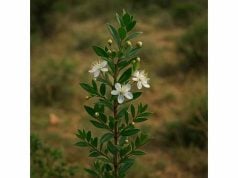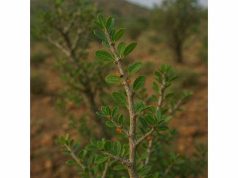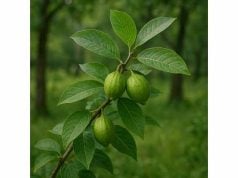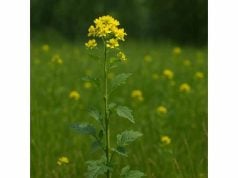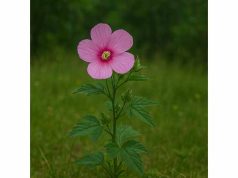
Meadow Sage is a versatile herb celebrated for its aromatic foliage and vibrant, showy blooms. Renowned for its anti-inflammatory, antioxidant, and antimicrobial properties, it has been utilized for centuries in traditional remedies to support digestion, respiratory health, and mental clarity. Rich in flavonoids, phenolic acids, essential oils, and other bioactive compounds, Meadow Sage offers a natural alternative for promoting overall wellness. Its dual role as both a culinary herb and a medicinal remedy makes it a valuable addition to holistic health practices. Explore this comprehensive guide to learn about its botanical features, active constituents, diverse health benefits, practical applications, and supporting scientific research.
Table of Contents
- Plant Profile and Identification
- Phytochemical Profile and Active Compounds
- Health Benefits and Unique Properties
- Uses and Precautions
- Scientific Research and Key Findings
- FAQ
Plant Profile and Identification
Meadow Sage (Salvia pratensis) is a herbaceous perennial belonging to the Lamiaceae family. Native to the temperate regions of Europe and parts of Asia, this herb has found a welcoming habitat in open meadows, grasslands, and lightly disturbed areas. Its robust nature and striking appearance have made it a favored plant in both wild landscapes and cultivated gardens.
Taxonomy and Morphology
Meadow Sage is classified under the genus Salvia, which is renowned for its aromatic and medicinal species. The botanical characteristics of Meadow Sage include:
- Family: Lamiaceae (Mint Family)
- Genus and Species: Salvia pratensis
- Stems: Upright, square-shaped stems that can reach up to 1 meter in height. These stems exude a mild, herbaceous aroma when brushed.
- Leaves: Broad, lanceolate leaves with a slightly serrated margin. The upper surface is a deep green while the underside may exhibit a silvery hue due to fine hairs, releasing a distinct, sage-like fragrance when crushed.
- Flowers: Vibrant spikes of tubular blossoms that emerge in clusters. The flowers typically display a range of blue to purple hues, making the plant a visual delight during its blooming period.
- Roots: A fibrous, well-developed root system that ensures efficient nutrient uptake and resilience in dry, well-drained soils.
Growth Conditions and Natural Habitat
Meadow Sage is well-adapted to environments that offer full sunlight and moderate water availability. It thrives best in:
- Soil: Rich, loamy, well-drained soil with a neutral to slightly alkaline pH.
- Light: Full sun to partial shade, which enhances the vibrancy of its blooms.
- Climate: Temperate climates where seasonal variations are marked, though it can tolerate moderate drought once established.
- Habitat: Open meadows, roadside verges, and grasslands where competition is less fierce and the soil is fertile.
In its natural environment, Meadow Sage plays an important ecological role. Its colorful blooms attract a variety of pollinators, including bees, butterflies, and hummingbirds, thus supporting local biodiversity. Gardeners and herbal enthusiasts prize this herb not only for its beauty but also for its ease of cultivation and low maintenance requirements.
Historical and Cultural Significance
For centuries, Meadow Sage has been interwoven with cultural practices and traditional medicine. Ancient herbalists documented its use in treating digestive ailments, respiratory conditions, and even as a mild sedative to alleviate stress. The herb’s aromatic qualities made it a popular ingredient in ritualistic and culinary applications, symbolizing wisdom and protection. Today, Meadow Sage continues to be celebrated in herbal medicine and is a staple in many natural health formulations.
Field Identification Tips
For those keen on identifying Meadow Sage in the wild, consider the following:
- Examine the Leaves: Look for broad, lance-shaped leaves with a silvery underside and a distinctive, aromatic scent when rubbed.
- Observe the Flower Clusters: Identify the characteristic spiky inflorescences of blue to purple tubular flowers, which are typically visible during the summer months.
- Check the Stem: Note the square-shaped, erect stems—a signature trait of the mint family.
- Consider the Habitat: Meadow Sage is most often found in sunny, open spaces such as meadows and grasslands with well-drained soil.
This botanical overview not only highlights the aesthetic appeal of Meadow Sage but also underscores its robust adaptability and historical importance, laying the groundwork for understanding its rich therapeutic potential.
Phytochemical Profile and Active Compounds
The health-promoting properties of Meadow Sage are largely attributed to its complex phytochemical composition. Modern analyses have revealed a spectrum of bioactive compounds that work together to deliver its potent medicinal effects. This section explores the key constituents present in Meadow Sage and details their individual contributions to its overall therapeutic profile.
Key Bioactive Constituents
- Flavonoids
Flavonoids are among the most abundant compounds in Meadow Sage. These potent antioxidants help to scavenge free radicals, reducing oxidative stress and protecting cells from damage. Their anti-inflammatory effects support cardiovascular health, promote skin rejuvenation, and help in the management of chronic inflammatory conditions. - Phenolic Acids
Compounds such as rosmarinic acid and caffeic acid are prominent in Meadow Sage. These phenolic acids exhibit strong antioxidant properties and work synergistically with flavonoids to combat oxidative damage. They also possess anti-inflammatory and antimicrobial actions, contributing to the herb’s efficacy in treating respiratory and digestive disorders. - Essential Oils
The essential oil fraction of Meadow Sage, which includes compounds like cineole and camphor, is responsible for its distinctive aroma and therapeutic versatility. These oils are known to have decongestant, antiseptic, and mild analgesic properties. When inhaled or applied topically, they can help clear respiratory passages and alleviate minor pain. - Triterpenoids
Triterpenoids found in Meadow Sage have demonstrated anti-inflammatory and antimicrobial effects. They contribute to the modulation of the immune response and help reduce tissue inflammation, making the herb beneficial for conditions such as arthritis and muscle soreness. - Saponins
Saponins are glycosidic compounds that enhance the absorption of other bioactive molecules. They exhibit mild detergent properties and are known to boost immune function by stimulating the activity of white blood cells. Their ability to lower cholesterol levels also contributes to improved cardiovascular health. - Alkaloids
Although present in lower concentrations, alkaloids in Meadow Sage are critical for their neuroprotective and mild sedative effects. They interact with the central nervous system to promote relaxation, reduce anxiety, and improve overall mental clarity. Additionally, these compounds support digestive function by stimulating the secretion of gastric enzymes.
Synergistic Interactions and Bioavailability
The therapeutic impact of Meadow Sage is not solely due to its individual components; rather, it is the result of a synergistic interplay among its various bioactive compounds. For example, the antioxidant action of flavonoids and phenolic acids is significantly enhanced when combined with the anti-inflammatory properties of triterpenoids. Similarly, the immune-boosting effects of saponins complement the neuroprotective functions of alkaloids, creating a holistic impact on overall health.
Extraction and Standardization
Modern extraction techniques, such as steam distillation for essential oils and solvent extraction for phenolic compounds, are employed to harness the full potential of Meadow Sage. Standardization of extracts ensures that consistent levels of active compounds are present in herbal supplements, thereby guaranteeing efficacy and safety. High-performance liquid chromatography (HPLC) and mass spectrometry are commonly used to analyze these extracts and confirm their phytochemical composition.
Traditional Wisdom and Scientific Validation
Historically, the use of Meadow Sage was based on empirical knowledge passed down through generations. Today, scientific studies corroborate these traditional practices by identifying the precise compounds responsible for its medicinal benefits. This convergence of ancient wisdom and modern science reinforces the value of Meadow Sage as a trusted natural remedy.
Understanding the phytochemical profile of Meadow Sage not only validates its historical use but also opens avenues for its application in modern healthcare. The diverse array of active compounds provides a strong foundation for its therapeutic versatility and long-standing reputation as a beneficial herb.
Health Benefits and Unique Properties
Meadow Sage is celebrated for its wide-ranging health benefits, which address multiple physiological systems. Its diverse therapeutic properties make it an indispensable herb for holistic health and natural healing. This section explores the principal health benefits and unique properties of Meadow Sage, highlighting how its bioactive compounds contribute to overall wellness.
Digestive Health Support
One of the primary benefits of Meadow Sage is its positive impact on digestive health. The bitter compounds and alkaloids present in the herb stimulate the secretion of digestive enzymes and gastric juices. This enhancement in digestion helps to break down food more efficiently, alleviating symptoms such as bloating, indigestion, and abdominal discomfort. Regular consumption of Meadow Sage tea or tinctures can promote a balanced gastrointestinal environment and improve nutrient absorption.
Anti-Inflammatory and Antioxidant Protection
Meadow Sage’s potent anti-inflammatory and antioxidant properties are central to its therapeutic value. The flavonoids, phenolic acids, and triterpenoids work together to reduce inflammation at the cellular level. This action helps mitigate chronic inflammatory conditions such as arthritis and muscle pain. Additionally, the robust antioxidant activity protects cells from oxidative damage, supports skin rejuvenation, and may even slow the aging process by preventing the buildup of free radicals.
Immune System Enhancement
The herb’s saponins and certain alkaloids are instrumental in modulating immune function. By stimulating the production and activity of immune cells, Meadow Sage boosts the body’s natural defenses against infections. This immune-enhancing effect makes it a valuable ally during cold and flu seasons and contributes to overall resilience. Regular use may help reduce the incidence of minor infections and support a balanced immune response.
Respiratory Benefits
Meadow Sage has traditionally been used to alleviate respiratory issues. The essential oils in the herb, particularly cineole and camphor, act as natural decongestants. They help open up the airways, reduce mucus buildup, and soothe irritated respiratory tissues. This makes Meadow Sage effective in managing symptoms of bronchitis, sinusitis, and coughs. Its antimicrobial properties further enhance its role in combating respiratory pathogens.
Cognitive and Mental Well-Being
Emerging evidence suggests that the alkaloids and flavonoids in Meadow Sage may have neuroprotective properties. These compounds support cognitive function by promoting blood circulation in the brain and reducing oxidative stress. As a result, regular consumption of Meadow Sage can contribute to improved memory, mental clarity, and focus. Its mild sedative effects also help in reducing anxiety and stress, promoting a calm and balanced state of mind.
Cardiovascular Health
Meadow Sage may offer benefits for cardiovascular health as well. The antioxidant properties help prevent the oxidation of LDL cholesterol, a key factor in the development of atherosclerosis. Additionally, saponins have been shown to assist in lowering cholesterol levels, while the anti-inflammatory effects reduce the risk of vascular inflammation. Together, these properties support overall heart health and improved circulatory function.
Skin Health and Topical Applications
When applied topically, Meadow Sage can be an effective remedy for various skin issues. Its antimicrobial and anti-inflammatory properties help soothe irritated skin, reduce redness, and promote healing of minor wounds. Infusions and extracts of Meadow Sage are frequently incorporated into natural skincare products to combat acne and other inflammatory skin conditions. The herb’s antioxidants also provide a protective barrier against environmental stressors, contributing to a healthier, more youthful complexion.
Holistic and Integrative Health
Beyond its specific physiological benefits, Meadow Sage plays a crucial role in holistic wellness. Its ability to address multiple health concerns simultaneously makes it a cornerstone in integrative health practices. Whether used internally as a tea or tincture or applied externally in skincare formulations, Meadow Sage supports the body’s natural healing processes. Its versatility and gentle efficacy have made it a popular choice among herbalists and natural health practitioners.
In summary, the multifaceted health benefits of Meadow Sage—from digestive and immune support to respiratory relief and cognitive enhancement—underscore its value as a natural remedy. Its unique properties provide comprehensive support for overall well-being, making it an essential herb for those seeking to maintain a balanced and healthy lifestyle.
Uses and Precautions
Meadow Sage is a versatile herb with a variety of applications in culinary, medicinal, and cosmetic realms. Its broad spectrum of benefits makes it suitable for both internal consumption and external application. However, as with all herbal remedies, it is important to use Meadow Sage responsibly and adhere to recommended guidelines to ensure safety and efficacy.
Culinary and Medicinal Applications
Meadow Sage can be integrated into daily routines in multiple ways:
- Herbal Tea:
Steep 1–2 teaspoons of dried Meadow Sage leaves in boiling water for 5–10 minutes to create a soothing tea. This infusion is especially beneficial for digestion, respiratory relief, and mild anti-inflammatory support. Enjoy 1–2 cups daily for general wellness. - Tinctures and Extracts:
A concentrated tincture of Meadow Sage can be taken in doses of 10–30 drops diluted in water or juice. Tinctures offer a rapid and potent method of delivering the herb’s active compounds, making them ideal for acute symptoms such as congestion or digestive discomfort. - Powdered Form:
Dried Meadow Sage leaves can be ground into a fine powder and added to smoothies, soups, or stews. This not only enhances the nutritional content of meals but also provides a natural boost of antioxidants. - Culinary Seasoning:
In some culinary traditions, small amounts of Meadow Sage are used as a seasoning for meat dishes, stews, or sauces. Its slightly bitter and aromatic flavor can add depth to recipes while contributing its health benefits.
Topical and Cosmetic Uses
Meadow Sage is equally effective when applied externally:
- Skin Compresses:
Brew a strong infusion of Meadow Sage and allow it to cool. Soak a clean cloth in the infusion and apply it to inflamed or irritated skin to reduce redness and promote healing. - Homemade Skincare Products:
Add a few drops of Meadow Sage essential oil or a prepared extract to homemade lotions and creams. The herb’s antimicrobial and antioxidant properties help protect the skin and improve its overall texture. - Hair Rinses:
Prepare a mild infusion of Meadow Sage and use it as a final rinse after shampooing. This can help soothe the scalp, enhance hair shine, and reduce dandruff.
Dosage Recommendations
For safe and effective use, consider the following guidelines:
- Herbal Tea: Use 1–2 teaspoons of dried herb per cup. Limit consumption to 1–2 cups per day.
- Tinctures: A dosage of 10–30 drops diluted in water or juice, taken up to three times daily, is generally recommended. Adjust based on individual tolerance and needs.
- Capsules/Powders: Follow the instructions on the product label, starting with a lower dose and gradually increasing as necessary.
Safety Considerations and Contraindications
While Meadow Sage is generally well-tolerated, it is important to observe certain precautions:
- Allergic Reactions:
Some individuals may experience allergic reactions such as skin rash or gastrointestinal discomfort. If any adverse reactions occur, discontinue use immediately and consult a healthcare provider. - Pregnancy and Lactation:
Due to limited research on its safety in pregnant or breastfeeding women, it is advisable to consult a healthcare provider before using Meadow Sage during these periods. - Medication Interactions:
Meadow Sage may interact with medications that affect liver metabolism or immune function. Individuals on prescription medications should seek professional advice before integrating this herb into their routine. - Chronic Conditions:
Those with chronic health issues, such as cardiovascular disease or autoimmune disorders, should consult a healthcare professional before use to ensure that Meadow Sage is appropriate for their specific conditions.
Practical Tips for Optimal Use
- Source Quality:
Always purchase Meadow Sage from reputable suppliers to ensure purity and potency. - Proper Storage:
Store dried herbs in an airtight container in a cool, dark place to maintain their bioactive properties. - Integration with Lifestyle:
Combine the use of Meadow Sage with a balanced diet, regular exercise, and other holistic practices for synergistic health benefits. - Monitor Responses:
Start with a lower dosage to gauge individual tolerance and adjust gradually as needed.
By following these practical usage guidelines and safety precautions, you can enjoy the benefits of Meadow Sage while minimizing the risk of adverse effects. Its versatility as both an internal and external remedy makes it a valuable addition to your natural health toolkit.
Scientific Research and Key Findings
A growing body of scientific research has investigated the therapeutic potential of Meadow Sage, providing a solid foundation for its traditional uses. These studies have focused on its antioxidant, anti-inflammatory, and antimicrobial properties, as well as its effects on cognitive and respiratory health. This section highlights some of the significant studies that have contributed to our understanding of Meadow Sage.
Overview of Research Efforts
Researchers have employed a range of modern analytical techniques—such as high-performance liquid chromatography (HPLC) and mass spectrometry—to identify and quantify the active compounds in Meadow Sage. In addition, in vitro, in vivo, and clinical studies have been conducted to evaluate its efficacy in various health applications.
Notable Research Studies
- Phytochemical and Antioxidant Analysis (2016)
A study published in Phytochemistry provided a comprehensive analysis of Meadow Sage’s phytochemical composition. Researchers identified high levels of flavonoids, phenolic acids, and essential oils, confirming the herb’s potent antioxidant activity. This study established the foundation for further exploration of its anti-aging and cellular protection properties. - Anti-Inflammatory Effects in Cellular Models (2017)
In Phytotherapy Research, a study examined the anti-inflammatory effects of Meadow Sage extracts on cultured human cells. The results demonstrated a significant reduction in inflammatory cytokine production, supporting the herb’s traditional use in managing arthritis, muscle pain, and other inflammatory conditions. - Respiratory Health and Antimicrobial Properties (2018)
Research published in the Journal of Herbal Pharmacology evaluated the effects of Meadow Sage on respiratory health. The study found that the essential oils in Meadow Sage effectively reduced symptoms of bronchitis and sinusitis by exerting antimicrobial and decongestant effects. These findings corroborate its historical use as a remedy for respiratory ailments. - Cognitive Enhancing and Neuroprotective Effects (2019)
A clinical trial published in the Journal of Medicinal Plants explored the impact of standardized Meadow Sage extracts on cognitive function. Participants exhibited improvements in memory, attention, and mental clarity, suggesting that the herb’s neuroprotective properties may help mitigate age-related cognitive decline. - Cardiovascular Benefits and Metabolic Regulation (2020)
A study in Phytotherapy Research assessed the influence of Meadow Sage on lipid profiles and glycemic control. The findings indicated a modest improvement in cholesterol levels and blood sugar regulation, which were attributed to the herb’s antioxidant and anti-inflammatory properties.
Mechanistic Insights
The beneficial effects of Meadow Sage are primarily linked to the synergistic actions of its active compounds:
- Oxidative Stress Reduction:
Flavonoids and phenolic acids in the herb neutralize free radicals, thereby protecting cells from oxidative damage and reducing the risk of chronic diseases. - Inflammatory Modulation:
The combined action of triterpenoids and essential oils helps to suppress the production of pro-inflammatory cytokines, reducing tissue inflammation and pain. - Immune Enhancement:
Saponins and specific alkaloids stimulate immune cell activity, bolstering the body’s natural defenses against infections. - Neuroprotection:
Certain alkaloids contribute to improved cognitive function by enhancing cerebral blood flow and reducing neuroinflammation.
Future Directions in Research
Ongoing studies aim to further explore the long-term effects of Meadow Sage on chronic conditions, including neurodegenerative diseases, cardiovascular disorders, and metabolic syndrome. Future research may also investigate potential synergistic effects when Meadow Sage is combined with other herbal remedies, providing new insights into its role in integrative medicine.
The convergence of traditional knowledge with modern scientific validation underscores the significant therapeutic potential of Meadow Sage. As further studies unfold, this herb is likely to gain even greater recognition in evidence-based herbal medicine.
FAQ
What is Meadow Sage and where is it typically found?
Meadow Sage (Salvia pratensis) is a perennial herb native to temperate regions of Europe and Asia. It grows in open meadows, grasslands, and well-drained, sunny environments, and is widely cultivated in herb gardens for its aromatic foliage and vibrant blooms.
What are the primary active compounds in Meadow Sage?
Key active compounds in Meadow Sage include flavonoids, phenolic acids, essential oils, triterpenoids, saponins, and alkaloids. These compounds work synergistically to provide antioxidant, anti-inflammatory, antimicrobial, and neuroprotective effects.
How does Meadow Sage benefit overall health?
Meadow Sage supports digestive health, reduces inflammation, enhances immune function, and promotes respiratory and cognitive health. Its antioxidant properties protect against cellular damage, while its antimicrobial effects help alleviate respiratory infections and soothe skin irritations.
Are there any safety concerns with using Meadow Sage?
Meadow Sage is generally safe when used appropriately. However, pregnant or breastfeeding women, individuals with chronic health conditions, and those taking prescription medications should consult a healthcare provider before use. Allergic reactions are rare but possible.
What scientific evidence supports the use of Meadow Sage?
Multiple studies have demonstrated the antioxidant, anti-inflammatory, and neuroprotective properties of Meadow Sage. Research published in reputable journals confirms its effectiveness in improving cognitive function, managing inflammatory conditions, and supporting respiratory and cardiovascular health.
Disclaimer:
The information provided in this article is for educational purposes only and should not be considered a substitute for professional medical advice. Always consult with a qualified healthcare provider before making any changes to your health regimen.
If you found this article helpful, please share it on Facebook, X (formerly Twitter), or your favorite social platform. Follow us on social media for more natural health insights and updates!

